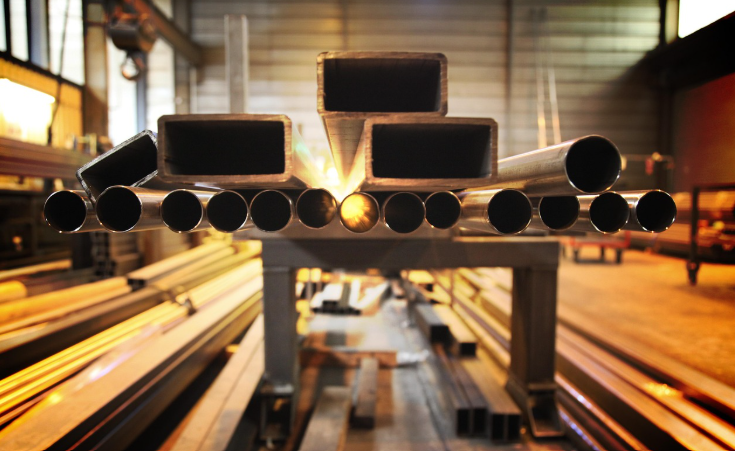Metal tubing is a very important material in several industries. Its power, hardiness, and accuracy make it essential in construction, automobile, hydraulics, and atmosphere. This manual covers all of the information on metal tubing such as definition, how it is made, major materials, practical application, and its maintenance.
What Is Metal Tubing?
Metal tubing Hollow cylindrical or rectangular hollows that are produced using metallic materials. Compared to solid rods, tubes have high strength-to-weight ratios, which are of high structural efficiency. Tubing is typically quantified in terms of its outside diameter (OD) and wall thickness, unlike piping, which is quantified with reference to internal bore size.
Where needed, be it in support frameworks or fluid systems or precision instruments, metal tubing is employed where strength, accuracy and long-term performance are needed.
Main Types of Metal Tubing
Metal Tubing is of two main types:
Seamless Tubing: A form of extrusion or piercing a solid billet to form a hollow tube. It provides high-pressure strength and even strength.
Welded Tubing: Created out of a flat strip of metal, which was rolled and welded along its length. It is economical, flexible and it is highly utilised in structural work.
Tubing is also available in different shapes round, square or rectangular. Oval and D-shaped tubes are commonly used in architecture and marine applications as custom profiles, either for aesthetic or functional purposes.
Manufacturing Processes
Metal tubing is manufactured by means of accurate metalwork and metallurgy:
Piercing or Extrusion: In seamless tubes, a heated billet is pierced and then drawn through dies to the required diameter.
Roll Forming and Welding: In the case of welded tubes, metal coils are rolled into cylinders and the seam is welded either with high-frequency or resistance.
Sizing and Straightening: The tube is sized in sizing mills so that it acquires an accuracy of tolerance and a surface finish.
Heat Treatment: Annealing or normalising helps in de-stressing internal as well as improving durability.
Surface Finishing: Polishing, plating or galvanising enhances appearance and resistance to corrosion.
The end performance characteristics depend on each stage and therefore, precision and quality control are highly essential.
Common Materials and Alloys
Various materials are appropriate in different settings and requirements. The most widely used are:
- Carbon steel and mild steel – Powerful, economical, and can be used in structures.
- Stainless steel (304, 316 grade) – Very resistant to corrosion and oxidation.
- Aluminium– Light in weight but strong enough to be transported and also in architectural work.
- Copper, brass and titanium – These metals find applications in specialised applications like atmosphere and marine engineering.
All compounds have an impact on strength, corrosion resistance, weldability and cost. The choice of the metal is critical in achieving both performance and longevity.
The Major Benefits of Metal Tubing.
Metal tubing has the following engineering advantages that have seen it be the choice material in most projects.
It offers an outstanding strength-to-weight ratio, and it is stable without being bulky. Its rigidity enables its structural integrity even during vibration and bending loads. The hollow structure enhances the economical use of materials whereas corrosive indefinite finishes increase the service life.
In addition, metal tubing is very versatile in all industries since it can be cut, bent, and welded with ease to suit a particular design.
Choosing the appropriate Metal tubing.
The selection of the appropriate tubing depends on the design and the environment. Key considerations include:
- Mechanical Load and Pressure: The high-pressure hydraulic systems use thicker-wall seamless tubes.
- Environmental Exposure: The stainless or galvanized tubing is the best choice in environments where it is exposed to the outdoors and marine conditions.
- Dimensional Tolerance: Dimensional tolerances are demanded in precision applications.
Industrial and Commercial Applications.
Metal tubing has many industries:
It is used in structures, scaffolds and in architecture by construction companies. The automobile industry depends on exhaust, roll cages, and fluid line tubing. Honed and chrome-plated tubes are used in hydraulics and pneumatics providing accuracy of performance in hydraulic cylinders and pistons.
It is also an important part of the atmosphere, marine and furniture production giving it strength, reliability, and flexibility of design. It is also equally appropriate in decorative and practical installation because of its clean look and mechanical strength.
Quality Standards and Certifications.
The suppliers are reliable and ensure that they adhere to the standards of both the UK and international. Quality assurance may involve:
- Dimensional inspection to AN or ASTM standards.
- Non-destructive tests like ultrasonic or eddy-current tests.
- Comparison of precision using surface and straightness evaluation.
Maintenance and Installation.
The right installation increases the service life of Metal Tubing. The cutting should be clean and square and burr must be removed to provide comfortable joints. Depending on the design of the system, tubing can be joined by welding, brazing or mechanical fittings.
Corrosion, cracks or deformation are also checked routinely during maintenance to prevent failure. Wipe inside clear passages particularly hydraulic systems to prevent contamination and wear.
Even minimal precautions such as proper installation, applying appropriate coating and conducting maintenance can help to prolong the working life of tubing by several years.
The New Trends in Metal Tubing.
The metal tubing industry is constantly developing in line with contemporary engineering demands. The new sustainable production approaches emphasise recycled metallurgy and low-carbon processes. The development of alloys is stronger at a reduced weight.
Manufacturers are also producing complicated, custom-shaped tubes in the use of precision roll forming. There is an increase in the use of smart tubing technologies, which have a sensor that is either temperature or pressure-monitoring. These inventions are an indication of a future where metal tubing continues to serve a more efficient and intelligent purpose in engineering design.
Conclusion
From the simple support structures to the complex hydraulic systems, the metal tubing remains the core of contemporary engineering. Its balance of power, accuracy, and versatility renders it necessary for several companies in the UK and other parts of the world.
Learning how seamless and welded tubing can impact the process, the significance of using alloy, and the relevance of quality standards, a professional will be able to ensure that performance and safety are approved in any application.
Regardless of the type of structure you are designing, heavy equipment maintenance, or finding good quality material used in it, select a supplier of metal tubing and you are sure to succeed in the long run.





